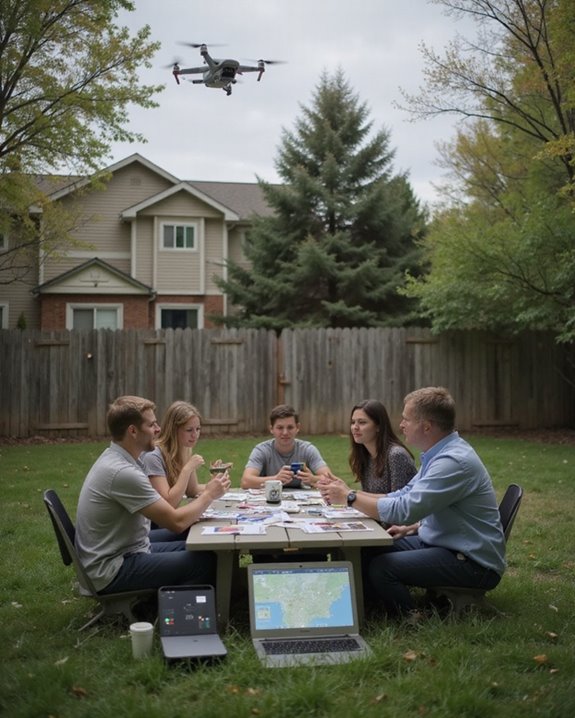Drones don’t get shot down over New Jersey because strict FAA rules and state laws make that a major no-no, plus it’s just not safe! Beyond the legal headaches, shooting down drones can rain debris onto people, cars, or even wildlife. Instead, officials use advanced tech—like Veeniix Remote ID Modules, RF scanners, and sharp surveillance systems—to track and control drones without destruction. Local cops and agencies all pitch in, making the skies safer and smarter. Want all the fascinating details?
Key Takeaways
- Shooting down drones is dangerous, risking injury to bystanders, damage to property, or harm to wildlife from falling debris.
- Federal and New Jersey laws prohibit destructive actions against drones, favoring reporting and monitoring suspicious activity instead.
- Advanced surveillance and detection technologies allow authorities to track and identify drones without resorting to force.
- Public education and responsible flying are emphasized over violent responses to promote community safety and compliance.
- Law enforcement and local agencies use legal, coordinated strategies—like RF-blocking and Remote ID—to manage drone threats effectively.
Legal Framework Governing Drone Operations
If you’ve ever looked up and spotted a whirring drone over New Jersey, you might have wondered who gets to decide where those little flying machines can go! It’s not just random—there’s actually a complex web of global regulations and historical laws at play. The Federal Aviation Administration (FAA) makes the main rules nationwide, so every drone—whether it’s snapping photos or delivering pizza—must follow FAA guidelines, including registration and Remote ID requirements. In New Jersey, state laws add extra layers, like criminal penalties for flying near prisons or interfering with emergency responders. Cities can’t just make up their own rules, either! Special no-fly zones around critical infrastructure are set by the FAA, and violating these could land operators in real trouble, both federally and locally. To help drone operators comply, devices like the Veeniix Remote ID Module offer real-time monitoring and ensure adherence to FAA regulations.
Safety Priorities Over Destructive Actions

Spotting a drone buzzing overhead might spark visions of dramatic action—maybe a superhero-style takedown or a wild chase across New Jersey’s skies! But actually, safety priorities come first. Shooting down drones isn’t just risky business—it can rain sharp debris on innocent bystanders, damage cars, or even hurt wildlife. Instead, officials promote public education about drone rules and ethical priorities, reminding everyone that rash actions aren’t just dangerous—they’re illegal. The FAA and local authorities say: don’t play drone dodgeball. Instead, they encourage reporting suspicious drone activity, using ground-based monitoring, and launching awareness campaigns (no capes required). Teaching responsible flying and community engagement keeps the skies friendly—and way less dramatic. After all, safety and smart choices always beat reckless heroics! Additionally, many areas rely on RF-blocking products to contain drone signals legally without resorting to destructive measures.
Security Concerns and Airspace Management
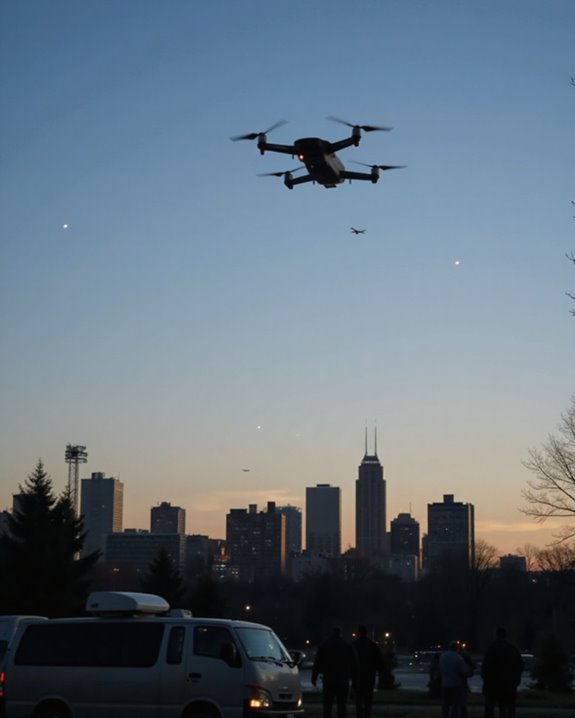
How do officials actually keep the skies over New Jersey safe from rogue drones, anyway? It’s not by grabbing a slingshot or playing drone tag! Instead, there’s careful airspace management. The FAA enforces strict rules—flying near critical infrastructure, correctional facilities, or under the influence is a crime. Advanced monitoring systems track drones, and if one strays, emergency protocols kick in fast. Coordination efforts between federal and local agencies make sure everyone’s on the same page, especially during incidents involving first responders. Height and geographic restrictions, like those in Atlantic Highlands and Linden, help keep drones out of trouble spots. Violators risk fines or legal action. With technology and teamwork, officials keep the skies orderly—no superhero capes required, just smart planning! Additionally, many drones are equipped with FAA Compliant Remote ID Modules that broadcast precise GPS data to enhance airspace safety and monitoring.
Local Restrictions and Municipal Oversight

Keeping drones in check across New Jersey isn’t just a job for the FAA or state police—local towns play their part, too! Even though federal rules set the big picture, local governments often step in by holding public forums to discuss drone safety and gather feedback. Want to know how your town feels about drones buzzing overhead? Check out your local advisory boards, which help guide decisions and shape public awareness campaigns. While state law limits towns from making their own drone rules (no “No-Fly Zones” over your neighbor’s backyard, sorry!), municipalities still work closely with federal agencies to protect schools, hospitals, and water plants. Local law enforcement pitches in, especially when drones threaten safety or property. It’s teamwork—with a dash of Jersey spirit!
Technological Solutions for Drone Detection
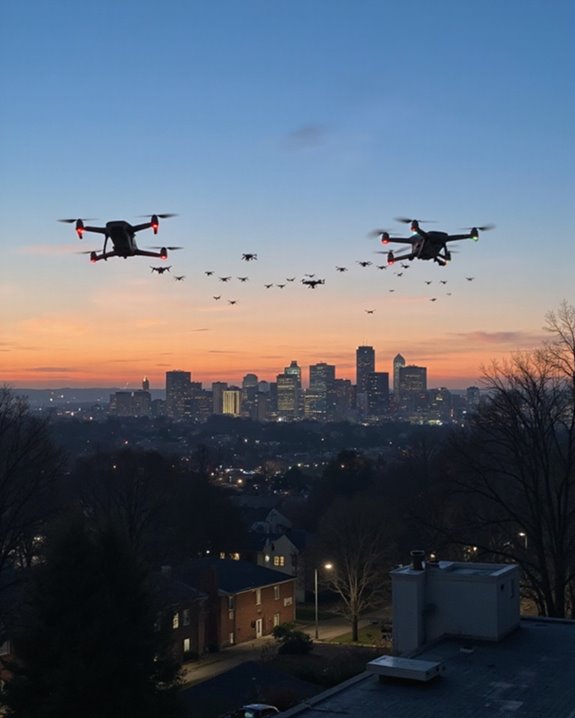
Ever wonder what actually goes on behind the scenes when someone needs to find a drone in the sky? It’s not just binoculars and guesswork! Today’s drone detection relies on RF Tracking and powerful AI Algorithms, which scan the skies for signals and patterns. At Cape May, New Jersey, the FAA is running daytime tests, using over 100 commercial drones to see which technologies work best. These systems don’t just spot the drone; they can find the pilot too! Multi-layer detection, including Remote ID integration, means authorities can quickly figure out if a drone is behaving badly. By expanding testing to places like ferry terminals, experts guarantee tech can handle busy, unpredictable areas. It’s all about keeping everyone—on the ground and in the air—safe.
Risk Assessment and Liability Issues
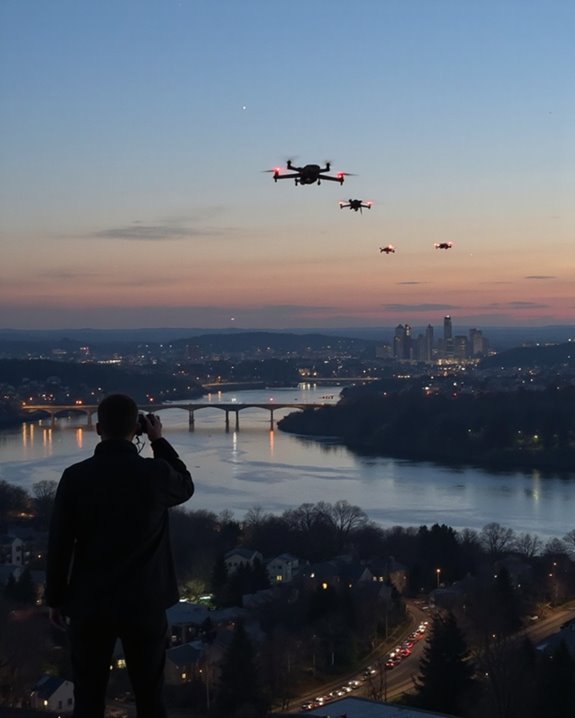
Curiously enough, when drones buzz above New Jersey neighborhoods or critical sites, it’s not just about spotting them—it’s about figuring out who’s responsible and what could go wrong! Risk Evaluation starts with the law: the FAA and state rules make a tangled web of do’s and don’ts, especially near places like airports or prisons. If a drone crashes into a backyard barbecue or zips too close to a power plant, Liability Prevention becomes serious business. Owners can face disorderly person charges or even bigger trouble if they endanger life or property. Insurance helps, but you can’t just say “oops!” and hope for the best. Reporting incidents, staying educated, and following safety training are key—because in New Jersey, ignorance is definitely not bliss!
Privacy and Public Perception Dynamics
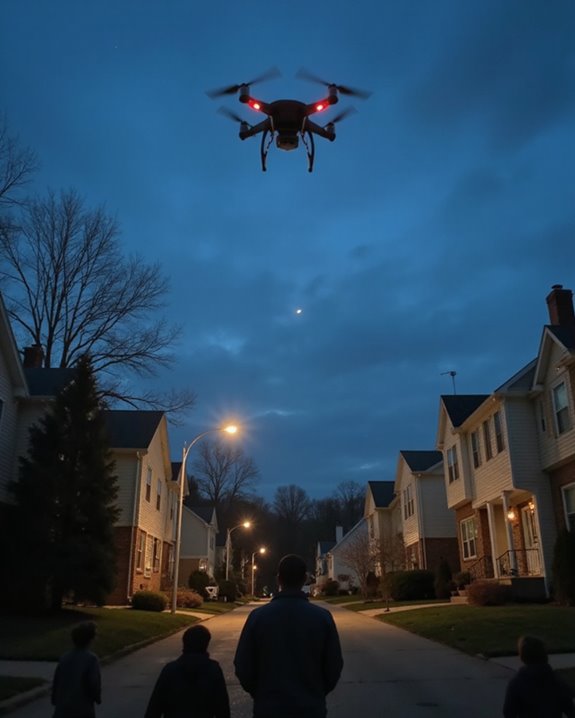
How does a buzzing drone overhead make you feel—excited, curious, or maybe just a tiny bit annoyed? For many in New Jersey, drones spark Perception Shifts: one moment they’re useful tools for aerial photography, the next, they raise privacy alarms! People worry about data collection, unwanted surveillance, and what’s really happening behind those camera lenses. These concerns feed Ethical Debates—should drones film public spaces without consent? Laws try to keep up, but gaps remain, leading to heated discussions, especially as media reports spotlight drone mishaps. Yet, education and community engagement are changing minds, helping people see both sides. While some folks embrace the tech, others watch the skies suspiciously, wondering if drones are friends, foes, or just noisy neighbors with wings!
Economic Impact of Drone Industries
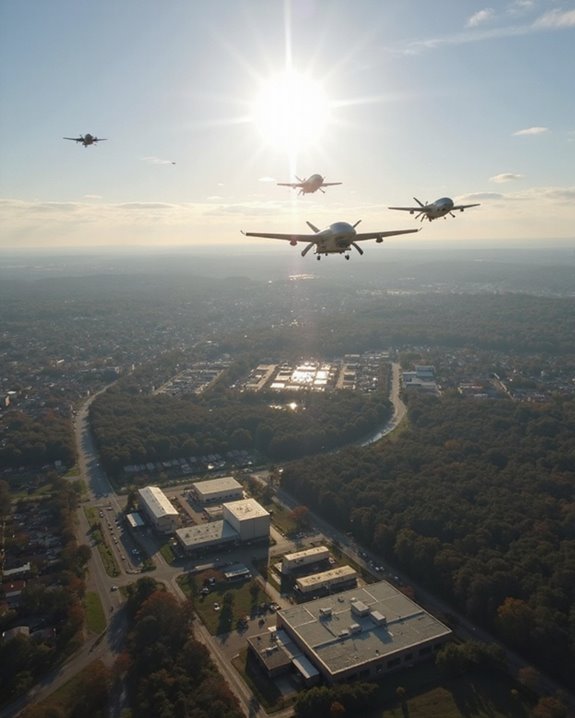
Picture New Jersey not just as the Garden State, but as a buzzing launchpad for the drone economy! Across Cape May County and beyond, drones are sparking Job Opportunities as they zip through construction sites, farms, and city skies. The state isn’t just growing tomatoes—it’s nurturing high-tech businesses, thanks to Economic Diversification aimed at making drones part of daily life. Proximity to New York means less restricted airspace, so startups and innovators flock here. Local airports welcome both manned and unmanned aircraft, fueling infrastructure growth and mapping projects. From drone air shows in Jersey City to agricultural monitoring in rural towns, innovation clusters are forming. New Jersey’s drone sector isn’t just flying high; it’s helping the economy soar, one buzzing propeller at a time!
Enforcement Strategies and Government Response
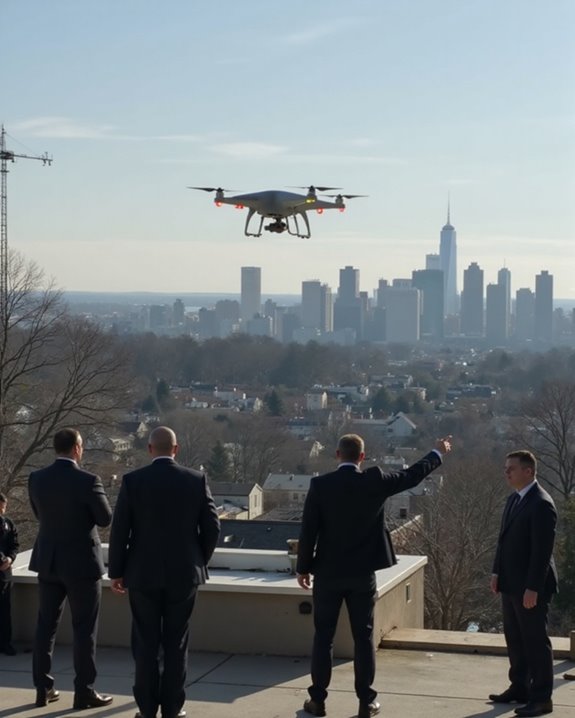
Ever wonder who’s actually keeping an eye on all those buzzing drones over New Jersey? It’s a team effort! Local police, the New Jersey Office of Homeland Security and Preparedness, and even federal agencies work together to track and respond to drone sightings. But it’s not just about having a watchful eye—enforcement strategies include UAS training programs for law enforcement and advanced surveillance systems, though telling drones apart from planes can be tricky! Response planning gets a boost from funding strategies aimed at better drone detection and upgraded communication. Leaders like Congresswoman Mikie Sherrill push for unified plans, while airspace restrictions and new tech help keep the skies safe. With all these moving parts, New Jersey’s drone patrol is anything but boring!
Frequently Asked Questions
Can Private Citizens Legally Shoot Down a Drone Over Their Property?
Private citizens cannot legally shoot down a drone over their property, as federal law prohibits such actions. Legal defenses based on ownership rights are limited; violators risk civil penalties, criminal charges, and potential safety hazards.
What Happens to a Drone if It Crashes in a Restricted Area?
When a drone crashes in a restricted area, the event ripples outward like a stone in a pond, triggering crash effects such as property damage, liability ramifications for the operator, and official investigations into regulatory or safety violations.
Are There Wildlife Risks Associated With Shooting Down Drones?
Shooting down drones presents wildlife risks, including potential animal injuries from falling debris and a broader ecological impact if sensitive habitats are disturbed. The act can exacerbate stress or displace species, compounding existing environmental concerns.
How Do Drone Operators Recover Drones Lost in No-Fly Zones?
Recovery strategies rely on reviewing flight logs, deploying locator beacons, and systematically searching mapped areas; operators often coordinate with authorities, request access, and document efforts, balancing technology and procedure to retrieve drones lost within no-fly zones’ strict boundaries.
Can Drone Owners Track Their Drones if Confiscated by Authorities?
The current question addresses whether drone owners can track confiscated drones. While drones often have GPS capabilities, authorities may disable tracking to prevent interference, raising privacy concerns about owner access to drone location during official investigations or seizures.


